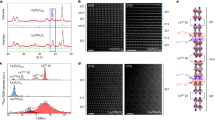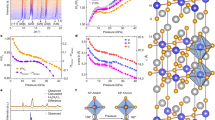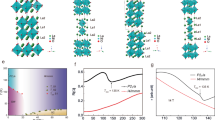Abstract
The discovery of high-temperature superconductivity under high pressure in Ruddlesden–Popper phase nickelates has captured notable attention in the condensed matter physics community. Here we report superconductivity in a distinct hybrid nickelate, La5Ni3O11, formed by alternating stacks of La3Ni2O7 and La2NiO4 layers. This nickelate also exhibits a density-wave transition at approximately 170 K near ambient pressure. With increasing pressure, this density-wave transition shifts to higher temperatures and abruptly disappears around 12 GPa, followed by the emergence of superconductivity, indicating a first-order phase transition. But the optimal superconductivity with large superconducting volume fraction is observed at approximately 21 GPa with \({T}_{{\rm{c}}}^{{\;\rm{zero}}}\) = 54 K. High-pressure X-ray diffraction experiments reveal a structural phase transition from an orthorhombic structure to a tetragonal structure at lower pressure. Notably, this structural change has minimal impact on the density-wave or superconducting phases, suggesting a limited role of lattice degrees of freedom in this material. These findings establish La5Ni3O11 as a new superconducting member of the Ruddlesden–Popper nickelate family and offer valuable insights into the interplay between structure, electronic order and superconductivity in hybrid nickelates.
This is a preview of subscription content, access via your institution
Access options
Access Nature and 54 other Nature Portfolio journals
Get Nature+, our best-value online-access subscription
$32.99 / 30 days
cancel any time
Subscribe to this journal
Receive 12 print issues and online access
$259.00 per year
only $21.58 per issue
Buy this article
- Purchase on SpringerLink
- Instant access to full article PDF
Prices may be subject to local taxes which are calculated during checkout





Similar content being viewed by others
Data availability
The data supporting the findings of this study are available via figshare at https://doi.org/10.6084/m9.figshare.29484635 (ref. 31). The detailed crystal structure data from this study have been deposited in the Cambridge Crystallographic Data Centre (CCDC) website with the deposition number CSD 2469506. These data are available from the corresponding author upon request. Source data are provided with the paper.
Code availability
The codes that support the findings of this study are available from the corresponding author upon request.
References
Bednorz, J. G. & Müller, K. A. Possible high Tc superconductivity in the Ba–La–Cu–O system. Z. Phys. B: Condens. Matter 64, 189–193 (1986).
Norman, M. R. Materials design for new superconductors. Rep. Prog. Phys. 79, 074502 (2016).
Azuma, M., Hiroi, Z., Takano, M., Bando, Y. & Takeda, Y. Superconductivity at 110 K in the infinite-layer compound (Sr1-xCax)1-yCuO2. Nature 356, 775–776 (1992).
Anisimov, V. I., Bukhvalov, D. & Rice, T. M. Electronic structure of possible nickelate analogs to the cuprates. Phys. Rev. B 59, 7901–7906 (1999).
Lee, K.-W. & Pickett, W. E. Infinite-layer LaNiO2: Ni1+ is not Cu2+. Phys. Rev. B 70, 165109 (2004).
Crespin, M., Levitz, P. & Gatineau, L. Reduced forms of LaNiO3 perovskite. Part 1.—Evidence for new phases: La2Ni2O5 and LaNiO2. J. Chem. Soc. Faraday Trans. 79, 1181–1194 (1983).
Hayward, M. A., Green, M. A., Rosseinsky, M. J. & Sloan, J. Sodium hydride as a powerful reducing agent for yopotactic oxide deintercalation: synthesis and characterization of the nickel(I) oxide LaNiO2. J. Am. Chem. Soc. 121, 8843–8854 (1999).
Li, D. et al. Superconductivity in an infinite-layer nickelate. Nature 572, 624–627 (2019).
Sun, H. et al. Signatures of superconductivity near 80 K in a nickelate under high pressure. Nature 621, 493–498 (2023).
Li, Q. et al. Signature of superconductivity in pressurized La4Ni3O10. Chin. Phys. Lett. 41, 017401 (2024).
Zhu, Y. et al. Superconductivity in tri-layer nickelate La4Ni3O10 single crystals. Nature 631, 531–536 (2024).
Zhang, M. et al. Superconductivity in tri-layer nickelate La4Ni3O10 under pressure. Phys. Rev. X 15, 021005 (2025).
Sakakibara, H. et al. Theoretical analysis on the possibility of superconductivity in the tri-layer Ruddlesden‒Popper nickelate La4Ni3O10 under pressure and its experimental examination: comparison with La3Ni2O7. Phys. Rev. B 109, 144511 (2024).
Dan, Z. et al. Pressure-enhanced spin-density-wave transition in double-layer nickelate La3Ni2O7−δ. Sci. Bull. 70, 1239–1245 (2025).
Chen, K. et al. Evidence of spin density waves in La3Ni2O7−δ. Phys. Rev. Lett. 132, 256503 (2024).
Zhang, J. et al. Intertwined density waves in a metallic nickelate. Nat. Commun. 11, 6003 (2020).
Zhang, Y. et al. High-temperature superconductivity with zero resistance and strange-metal behavior in La3Ni2O7−δ. Nat. Phys. 20, 1269–1273 (2024).
Li, F. et al. Design and synthesis of three-dimensional hybrid Ruddlesden‒Popper nickelate single crystals. Phys. Rev. Mater. 8, 053401 (2024).
Chen, X. et al. Polymorphism in the Ruddlesden–Popper nickelate La3Ni2O7: discovery of a hidden phase with distinctive layer stacking. J. Am. Chem. Soc. 146, 3640–3645 (2024).
Puphal, P. et al. Unconventional crystal structure of the high-pressure superconductor La3Ni2O7. Phys. Rev. Lett. 133, 146002 (2024).
Shulga, S. V. et al. Upper critical field peculiarities of superconducting YNi2B2C and LuNi2B2C. Phys. Rev. Lett. 80, 1730 (1998).
Wang, N. et al. Bulk high-temperature superconductivity in pressurized tetragonal La2PrNi2O7. Nature 634, 579–584 (2024).
Shi, M. et al. Absence of superconductivity and density-wave transition in ambient-pressure tetragonal La4Ni3O10. Nat. Commun. 16, 2887 (2025).
Shi, M. et al. Prerequisite of superconductivity: SDW rather than tetragonal structure in double-layer La3Ni2O7−x. Preprint at https://arxiv.org/abs/2501.14202 (2025).
Li, J. et al. Identification of the superconductivity in bilayer nickelate La3Ni2O7 upon 100 GPa. Natl Sci. Rev. 12, nwaf220 (2025).
Liu, Y. et al. Superconductivity and normal-state transport in compressively strained La2PrNi2O7 thin films. Nat. Mater. 24, 1221–1227 (2025).
Zhou, G. et al. Ambient-pressure superconductivity onset above 40 K in (La,Pr)3Ni2O7 films. Nature 640, 641–646 (2025).
Thanh, T. D. et al. Structure, magnetic, and electrical properties of La2NiO4+δ compounds. IEEE Trans. Magn. 53, 8204904 (2017).
Prozorov, R. & Kogan, V. G. Effective demagnetizing factors of diamagnetic samples of various shapes. Phys. Rev. App. 10, 014030 (2018).
Wang, G. et al. Pressure-induced superconductivity in poly-crystalline La3Ni2O7−δ. Phys. Rev. X 14, 011040 (2024).
Shi, M. et al. Pressure induced superconductivity in hybrid Ruddlesden‒Popper La5Ni3O11 single crystals. Raw Data. figshare https://doi.org/10.6084/m9.figshare.29484635 (2025).
Acknowledgements
We acknowledge fruitful discussions with H. Mao, Z. Wang and Z. Xiang. We also thank Z. Zhu, F. Lan, Y. Liu and H. Lou for their experimental assistance. This work is supported by the National Key R&D Programme of the MOST of China (Grant No. 2022YFA1602601 (to X.C. and T.W.)), the National Natural Science Foundation of China (Grant Nos 12494592 (to M.S. and J.Y.), 12488201 (to X.C.), 11888101 (to X.C.), 12034004 (to T.W.), 12161160316 (to T.W.), 12325403 (to T.W.) and 12204448 (to M.S.)), the Chinese Academy of Sciences under contract no. JZHKYPT-2021-08 (to X.C., T.W. and J.Y.), the CAS Project for Young Scientists in Basic Research (Grant No. YBR-048 (to J.Y., T.W. and M.S.)) and the Innovation Programme for Quantum Science and Technology (Grant No. 2021ZD0302800 (to T.W. and X.C.)). D.P. and Q.Z. acknowledge the financial support from the Shanghai Science and Technology Committee (Grant No. 22JC1410300 (to Q.Z. and D.P.)) and Shanghai Key Laboratory of Material Frontiers Research in Extreme Environments (Grant No. 22dz2260800 (to Q.Z. and D.P.)). A portion of this research used resources at the beamline 17UM of the Shanghai synchrotron radiation facility (https://cstr.cn/31124.02.SSRF.BL17UM).
Author information
Authors and Affiliations
Contributions
X.C. conceived the research project and coordinated the experiments. M.S. grew the single crystals and performed the structural characterization at ambient pressure with the help of R.W. and M.D. H.L. and K.F. measured the magnetic torque data. S.Y. and B.G. collected the TEM images. D.P. performed the resistance measurements using helium gas as the pressure-transmitting medium under pressure with the help of Q.Z. D.P., Z.X. and Y.W. performed the synchrotron powder diffraction measurements and analysis under high pressure using helium gas as the pressure-transmitting medium with help from Q.Z. and Z.Z. M.S., D.P., J.Y., T.W. and X.C. analysed the data. M.S., D.P., K.F., T.W. and X.C. wrote the paper with input from all the authors.
Corresponding authors
Ethics declarations
Competing interests
The authors declare no competing interests.
Peer review
Peer review information
Nature Physics thanks Weiwei Xie and the other, anonymous, reviewer(s) for their contribution to the peer review of this work.
Additional information
Publisher’s note Springer Nature remains neutral with regard to jurisdictional claims in published maps and institutional affiliations.
Extended data
Extended Data Fig. 1 Reciprocal lattice data.
(a)–(c), Reciprocal lattice data of La5Ni3O11 along the a*, b* and c* axes, respectively. The size of the spots represents the intensity of the diffraction peaks.
Extended Data Fig. 2 EDX results of the as-grown microcrystals.
The element ratio is La:Ni = 1.67:1, which is consistent with the chemical formula of La5Ni3O11.
Extended Data Fig. 3 Resistance curves for sample S1.
Temperature-dependent resistance curves for La5Ni3O11 (S1) at various pressures.
Extended Data Fig. 4 Superconductivity and the upper critical field.
(a) R(T) curves for La5Ni3O11 (S3) at 18.2 GPa under various magnetic fields along the c-axis direction. The onset Tc is quickly suppressed to a lower temperature with increasing magnetic field. (b) The upper critical field extracted with different criteria in (a), where the RN is the resistance at the normal state. There is an obvious positive curvature in the Hc2-Tc curve. The upper critical field at the zero-temperature limit is fitted via the two-band model at the clean limit.
Extended Data Fig. 5 Powder XRD patterns of the La5Ni3O11 crystal under various pressures.
(a) Powder XRD patterns of the La5Ni3O11 crystal under various pressures in the 2ϴ range of 12–14°, where the dashed line indicates the signal from the gasket (Re). (b) Rietveld refinement of the powder XRD pattern for La5Ni3O11 at 5.8 GPa. The collected data can be well fitted via the space group P4/mmm. The blue circles and red lines represent the observed and calculated data, respectively. The blue lines indicate the difference between the observed and calculated data. The short green and cyan vertical lines indicate the calculated diffraction peak positions of La5Ni3O11 with P4/mmm space group and Re.
Supplementary information
Source Data Fig. 1
Structure and density-wave transition at nearly ambient pressure.
Source Data Fig. 2
Electrical transport properties under high pressure.
Source Data Fig. 3
Magnetic susceptibility under high pressure.
Source Data Fig. 4
Structural evolution under high pressure.
Source Data Fig. 5
Phase diagram.
Source Data Extended Data Fig. 2
EDX results.
Source Data Extended Data Fig. 3
Resistance curves for sample S1.
Source Data Extended Data Fig. 4
Superconductivity and the upper critical fields.
Source Data Extended Data Fig. 5
Powder XRD patterns under various pressures.
Rights and permissions
Springer Nature or its licensor (e.g. a society or other partner) holds exclusive rights to this article under a publishing agreement with the author(s) or other rightsholder(s); author self-archiving of the accepted manuscript version of this article is solely governed by the terms of such publishing agreement and applicable law.
About this article
Cite this article
Shi, M., Peng, D., Fan, K. et al. Pressure induced superconductivity in hybrid Ruddlesden‒Popper La5Ni3O11 single crystals. Nat. Phys. (2025). https://doi.org/10.1038/s41567-025-03023-3
Received:
Accepted:
Published:
DOI: https://doi.org/10.1038/s41567-025-03023-3
This article is cited by
-
Impact of pressure and apical oxygen vacancies on superconductivity in La3Ni2O7
Communications Physics (2025)



